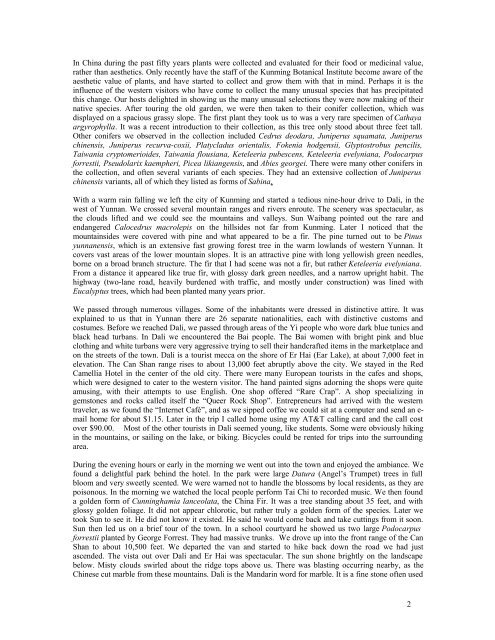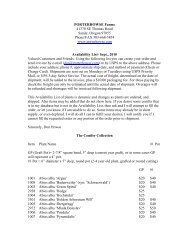CONIFERS IN YUNNAN.pdf - Porterhowse Farms
CONIFERS IN YUNNAN.pdf - Porterhowse Farms
CONIFERS IN YUNNAN.pdf - Porterhowse Farms
Create successful ePaper yourself
Turn your PDF publications into a flip-book with our unique Google optimized e-Paper software.
In China during the past fifty years plants were collected and evaluated for their food or medicinal value,rather than aesthetics. Only recently have the staff of the Kunming Botanical Institute become aware of theaesthetic value of plants, and have started to collect and grow them with that in mind. Perhaps it is theinfluence of the western visitors who have come to collect the many unusual species that has precipitatedthis change. Our hosts delighted in showing us the many unusual selections they were now making of theirnative species. After touring the old garden, we were then taken to their conifer collection, which wasdisplayed on a spacious grassy slope. The first plant they took us to was a very rare specimen of Cathayaargyrophylla. It was a recent introduction to their collection, as this tree only stood about three feet tall.Other conifers we observed in the collection included Cedrus deodara, Juniperus squamata, Juniperuschinensis, Juniperus recurva-coxii, Platycladus orientalis, Fokenia hodgensii, Glyptostrobus pencilis,Taiwania cryptomerioides, Taiwania flousiana, Keteleeria pubescens, Keteleeria evelyniana, Podocarpusforrestii, Pseudolarix kaempheri, Picea likiangensis, and Abies georgei. There were many other conifers inthe collection, and often several variants of each species. They had an extensive collection of Juniperuschinensis variants, all of which they listed as forms of Sabina.With a warm rain falling we left the city of Kunming and started a tedious nine-hour drive to Dali, in thewest of Yunnan. We crossed several mountain ranges and rivers enroute. The scenery was spectacular, asthe clouds lifted and we could see the mountains and valleys. Sun Waibang pointed out the rare andendangered Calocedrus macrolepis on the hillsides not far from Kunming. Later I noticed that themountainsides were covered with pine and what appeared to be a fir. The pine turned out to be Pinusyunnanensis, which is an extensive fast growing forest tree in the warm lowlands of western Yunnan. Itcovers vast areas of the lower mountain slopes. It is an attractive pine with long yellowish green needles,borne on a broad branch structure. The fir that I had scene was not a fir, but rather Keteleeria evelyniana.From a distance it appeared like true fir, with glossy dark green needles, and a narrow upright habit. Thehighway (two-lane road, heavily burdened with traffic, and mostly under construction) was lined withEucalyptus trees, which had been planted many years prior.We passed through numerous villages. Some of the inhabitants were dressed in distinctive attire. It wasexplained to us that in Yunnan there are 26 separate nationalities, each with distinctive customs andcostumes. Before we reached Dali, we passed through areas of the Yi people who wore dark blue tunics andblack head turbans. In Dali we encountered the Bai people. The Bai women with bright pink and blueclothing and white turbans were very aggressive trying to sell their handcrafted items in the marketplace andon the streets of the town. Dali is a tourist mecca on the shore of Er Hai (Ear Lake), at about 7,000 feet inelevation. The Can Shan range rises to about 13,000 feet abruptly above the city. We stayed in the RedCamellia Hotel in the center of the old city. There were many European tourists in the cafes and shops,which were designed to cater to the western visitor. The hand painted signs adorning the shops were quiteamusing, with their attempts to use English. One shop offered “Rare Crap”. A shop specializing ingemstones and rocks called itself the “Queer Rock Shop”. Entrepreneurs had arrived with the westerntraveler, as we found the “Internet Café”, and as we sipped coffee we could sit at a computer and send an e-mail home for about $1.15. Later in the trip I called home using my AT&T calling card and the call costover $90.00. Most of the other tourists in Dali seemed young, like students. Some were obviously hikingin the mountains, or sailing on the lake, or biking. Bicycles could be rented for trips into the surroundingarea.During the evening hours or early in the morning we went out into the town and enjoyed the ambiance. Wefound a delightful park behind the hotel. In the park were large Datura (Angel’s Trumpet) trees in fullbloom and very sweetly scented. We were warned not to handle the blossoms by local residents, as they arepoisonous. In the morning we watched the local people perform Tai Chi to recorded music. We then founda golden form of Cunninghamia lanceolata, the China Fir. It was a tree standing about 35 feet, and withglossy golden foliage. It did not appear chlorotic, but rather truly a golden form of the species. Later wetook Sun to see it. He did not know it existed. He said he would come back and take cuttings from it soon.Sun then led us on a brief tour of the town. In a school courtyard he showed us two large Podocarpusforrestii planted by George Forrest. They had massive trunks. We drove up into the front range of the CanShan to about 10,500 feet. We departed the van and started to hike back down the road we had justascended. The vista out over Dali and Er Hai was spectacular. The sun shone brightly on the landscapebelow. Misty clouds swirled about the ridge tops above us. There was blasting occurring nearby, as theChinese cut marble from these mountains. Dali is the Mandarin word for marble. It is a fine stone often used2




